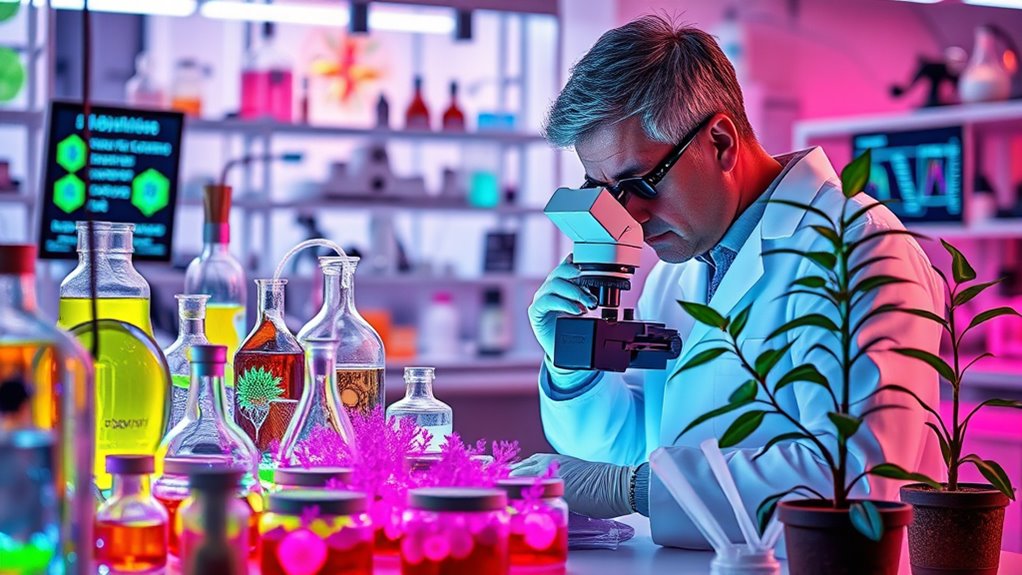Synthetic biology is changing the game by letting you create custom organisms. With tools like CRISPR-Cas9, you can edit DNA precisely, introducing traits that can help fight diseases or boost crop yields. This innovative approach opens the door to tackling food security and climate challenges. However, it also poses ethical questions and risks to ecosystems. There’s a lot more to this exciting field, so keep exploring its implications and advancements.
Key Takeaways
- Synthetic biology merges biology and engineering, enabling the creation of organisms with tailored traits for diverse applications.
- CRISPR-Cas9 technology has revolutionized gene editing, allowing precise DNA modifications to enhance beneficial traits in organisms.
- Custom organisms can address global challenges, including food security and climate change, by providing innovative solutions.
- Ethical considerations, such as ecosystem impacts and genetic enhancement, are crucial in the discourse surrounding synthetic biology advancements.
- Responsible development and regulatory frameworks are essential to mitigate risks and guide the future of synthetic biology.

As you explore the fascinating world of synthetic biology, you’ll discover how scientists combine biology and engineering to create new life forms and systems. This innovative field pushes the boundaries of what’s possible, enabling researchers to design organisms with specific traits for various applications, from medicine to environmental sustainability. One of the most powerful tools in this domain is gene editing, which allows for precise modifications to an organism’s DNA. Techniques like CRISPR-Cas9 have revolutionized the way scientists can alter genetic material, making it easier than ever to introduce beneficial traits or remove harmful ones.
Imagine being able to engineer bacteria to produce biofuels, or design plants that can thrive in extreme conditions. With gene editing, you’re not just dreaming; you’re witnessing the dawn of a new era in biological engineering. This technology provides the means to tackle some of the world’s pressing challenges, such as food security, disease management, and climate change. However, as you explore more deeply into synthetic biology, you’ll inevitably confront the ethical considerations that accompany such powerful capabilities.
Witness the dawn of a new era in biological engineering, where gene editing tackles food security, disease management, and climate change.
The ability to edit genes raises significant questions about the implications of creating new life forms. Who decides which traits are desirable? What if an experiment goes wrong and the modified organism causes unforeseen consequences in the ecosystem? These dilemmas highlight the importance of regulatory frameworks and public discourse around synthetic biology. You can’t overlook the potential risks associated with gene editing, as they could impact biodiversity and the balance of natural systems.
Moreover, ethical considerations extend beyond the environment to human health. As scientists endeavor to develop gene therapies for genetic disorders, discussions about the implications of “designer babies” and genetic enhancement become increasingly relevant. You might wonder whether we should allow such modifications and who would have access to these technologies. It’s vital to engage in these conversations, as the decisions made today will shape the future of synthetic biology and its impact on society.
As you navigate this complex landscape, remember that synthetic biology holds immense promise, but it also demands responsibility and ethical foresight. Balancing innovation with caution is key to harnessing the benefits of gene editing while minimizing potential harm. Embracing this dual approach will allow you to contribute thoughtfully to the ongoing dialogue surrounding the rise of synthetic biology and its role in our world.
Frequently Asked Questions
What Are the Ethical Concerns Surrounding Synthetic Biology?
When you think about the ethical concerns surrounding synthetic biology, biosafety concerns and intellectual property come to mind. You might worry about the potential risks of engineered organisms escaping into the wild or causing unintended harm. Additionally, the ownership of genetic materials raises questions about who truly benefits from these innovations. Balancing innovation with safety and fairness is essential, as it affects both the environment and society’s trust in scientific advancements.
How Does Synthetic Biology Differ From Genetic Engineering?
Synthetic biology dances on the frontier of innovation, while genetic engineering is more like a skilled sculptor chiseling away at existing forms. You’ll find that gene editing focuses on altering specific genes within an organism, whereas biological design involves creating entirely new organisms with tailored functions. Fundamentally, genetic engineering fine-tunes nature, while synthetic biology composes a symphony of life from scratch, blending creativity with scientific precision.
Can Synthetic Organisms Survive in Natural Environments?
Synthetic organisms can survive in natural environments, but their success hinges on environmental adaptation. If they’re engineered to thrive in specific conditions, they might integrate seamlessly. However, you’ve got to consider the ecological impact; introducing these organisms could disrupt local ecosystems or outcompete native species. It’s essential to evaluate potential risks before releasing them into the wild, ensuring that the benefits outweigh the consequences for the environment and biodiversity.
What Regulatory Frameworks Exist for Synthetic Biology?
You’ll find that various regulatory frameworks exist for synthetic biology, primarily focusing on biosafety regulations and patent laws. Biosafety regulations guarantee that synthetic organisms are safely contained and monitored to prevent unintended consequences. Patent laws protect innovations, allowing creators to secure their inventions while promoting research. Different countries may have additional guidelines, but these fundamental frameworks help manage the balance between innovation and safety in the field of synthetic biology.
How Is Synthetic Biology Impacting the Job Market?
Synthetic biology’s transforming the job market by driving significant biotech job growth. You’ll notice a surge in demand for skilled professionals as synthetic biology startups emerge, creating innovative solutions across industries. This field’s expansion not only opens doors for researchers and engineers but also boosts roles in regulatory affairs and ethics. As companies seek talent, you could find exciting opportunities that blend science with entrepreneurial spirit, shaping the future of biotechnology.
Conclusion
As you explore the world of synthetic biology, it’s clear that creating custom organisms is just the tip of the iceberg. This field offers unprecedented opportunities to tackle global challenges, from health care to environmental sustainability. By harnessing the power of design and engineering, you’re not only pushing scientific boundaries but also paving the way for a brighter future. So, roll up your sleeves and embrace the potential—there’s a whole new world waiting to be explored!










